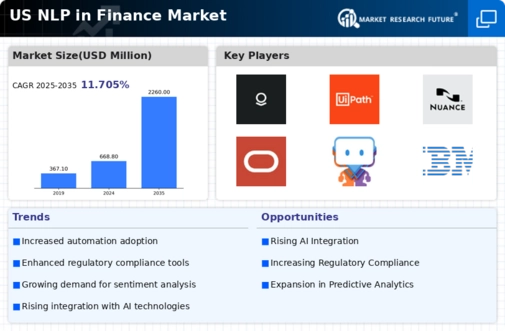Rise of Big Data Analytics
The proliferation of big data is a transformative force in the nlp in-finance market. Financial institutions are increasingly harnessing large datasets to gain insights into market trends, customer behavior, and operational efficiencies. The ability to analyze data at scale is expected to drive growth in the nlp in-finance market, with projections indicating a compound annual growth rate (CAGR) of 25% over the next five years. In the US, organizations are investing heavily in big data analytics tools that integrate NLP capabilities, enabling them to process and interpret vast amounts of information quickly. This trend not only enhances decision-making but also allows firms to identify emerging opportunities and threats, thereby fostering a more agile and responsive financial ecosystem.
Increased Focus on Customer Experience
The heightened emphasis on customer experience is reshaping the nlp in-finance market. Financial institutions are increasingly leveraging NLP technologies to enhance interactions with clients, providing personalized services and timely responses. Research indicates that organizations that prioritize customer experience can achieve revenue growth of up to 10% annually. In the US, this trend is particularly pronounced as consumers demand more intuitive and responsive financial services. By utilizing NLP to analyze customer interactions and feedback, firms can tailor their offerings to meet specific needs, thereby fostering loyalty and retention. This focus on customer-centric strategies is likely to drive innovation and investment in the nlp in-finance market, as companies seek to differentiate themselves in a crowded marketplace.
Regulatory Pressures and Compliance Needs
The evolving regulatory landscape is a critical driver of the nlp in-finance market. Financial institutions face increasing scrutiny from regulatory bodies, necessitating robust compliance measures. NLP technologies are being employed to automate the monitoring of regulatory changes and ensure adherence to complex legal requirements. In the US, the cost of non-compliance can reach millions of dollars, making it imperative for firms to invest in effective compliance solutions. By utilizing NLP to analyze regulatory texts and extract relevant information, organizations can streamline their compliance processes and mitigate risks. This trend not only enhances operational efficiency but also positions firms to respond proactively to regulatory changes, thereby reinforcing their standing in the nlp in-finance market.
Advancements in Machine Learning Algorithms
The rapid evolution of machine learning algorithms is a pivotal driver in the nlp in-finance market. These advancements enable financial institutions to process vast amounts of unstructured data, such as customer feedback and market sentiment, with unprecedented accuracy. For instance, the integration of deep learning techniques has shown to improve predictive analytics capabilities by up to 30%. As a result, firms can derive actionable insights that enhance their strategic decision-making processes. This trend is particularly relevant in the US, where the financial sector is increasingly reliant on data-driven methodologies. The ability to analyze and interpret complex datasets positions organizations to better understand customer needs and market dynamics, thereby fostering a more competitive landscape in the nlp in-finance market.
Growing Demand for Automation in Financial Services
The increasing demand for automation within financial services is significantly influencing the nlp in-finance market. Automation technologies, powered by natural language processing, streamline operations, reduce human error, and enhance efficiency. In the US, it is estimated that automation can lead to cost savings of approximately $400 billion annually across the financial sector. This shift towards automated solutions allows institutions to allocate resources more effectively, focusing on strategic initiatives rather than routine tasks. Consequently, the nlp in-finance market is witnessing a surge in the development of automated customer service solutions, fraud detection systems, and compliance monitoring tools, all of which are essential for maintaining competitiveness in a rapidly evolving industry.

















Leave a Comment